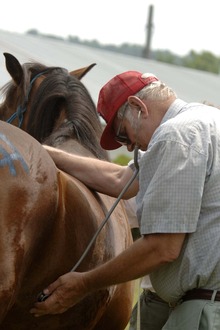With the advent of fiber optic gastroscopy, many veterinarians and horse owners have been surprised to find that the incidence of ulcers in horses is more common than once thought. Studies reveal that up to one-third of horses confined in stalls have ulcers and up to 60% of show horses and 90% of race horses may develop moderate to severe ulcers.

Checking horse gut health
Research shows the incidence of colonic ulcers in horses is on the rise over recent years, reaching as high as 84%.
© 2013 by Carien Schippers
As in humans, ulcers in horses affect the stomach and the duodenum. Superficial ulcers are patches of inflamed and eroded mucosa covered by pus. Deeper ulcers affect the layers of the stomach wall and can range from small, one-inch ulcers to ulcers that are several inches in diameter.
According to Frank Pellegrini, DVM, equine ulcers are the end results of a disease stage, typically gastritis or colitis. These lesions, or ulcers, represent syndromes in the sense that they reflect other, perhaps more extensive or serious, underlying disease states that, in turn, can lead to poor performance and impaired health.
Colitis is a syndrome of its own, producing mild to severe ulcers and presenting multiple symptoms. In our view, colitis is vastly under-diagnosed (unless showing a very acute course), while equine gastric ulcers are possibly over-diagnosed and over-treated.
Supporting Dr Pellegrini's research on gastritis and colitis incidence, diagnosis, and treatment is data from over 1,000 necropsies conducted in Texas and Quebec over a nine-year period starting in 2003. From that, researchers reported on an analysis of 524 horses with identical protocols.
Beginning with the first study, the researchers discovered that, in addition to gastric ulcers, horses suffered from colonic ulcers at rates exceeding 60%. The meta-analysis described in the complete study shows that on average, horses suffer moderate to severe ulceration in 44% of cases.
Post-mortem research has shown the incidence of colonic ulcers to be on the rise over recent years, from 63% in a 2004 study to as high as 84% in studies carried out from 2007 to 2011. In addition, a high degree of overlap between foregut and hindgut issues has also emerged.
Given these trends, comprehensive evaluation of gastrointestinal tract health is vital for the veterinarian to formulate an accurate diagnosis and effective treatment plan when ulcers or other pathological conditions of the GI tract are suspected.
Learn more about Ulcers in Horses
